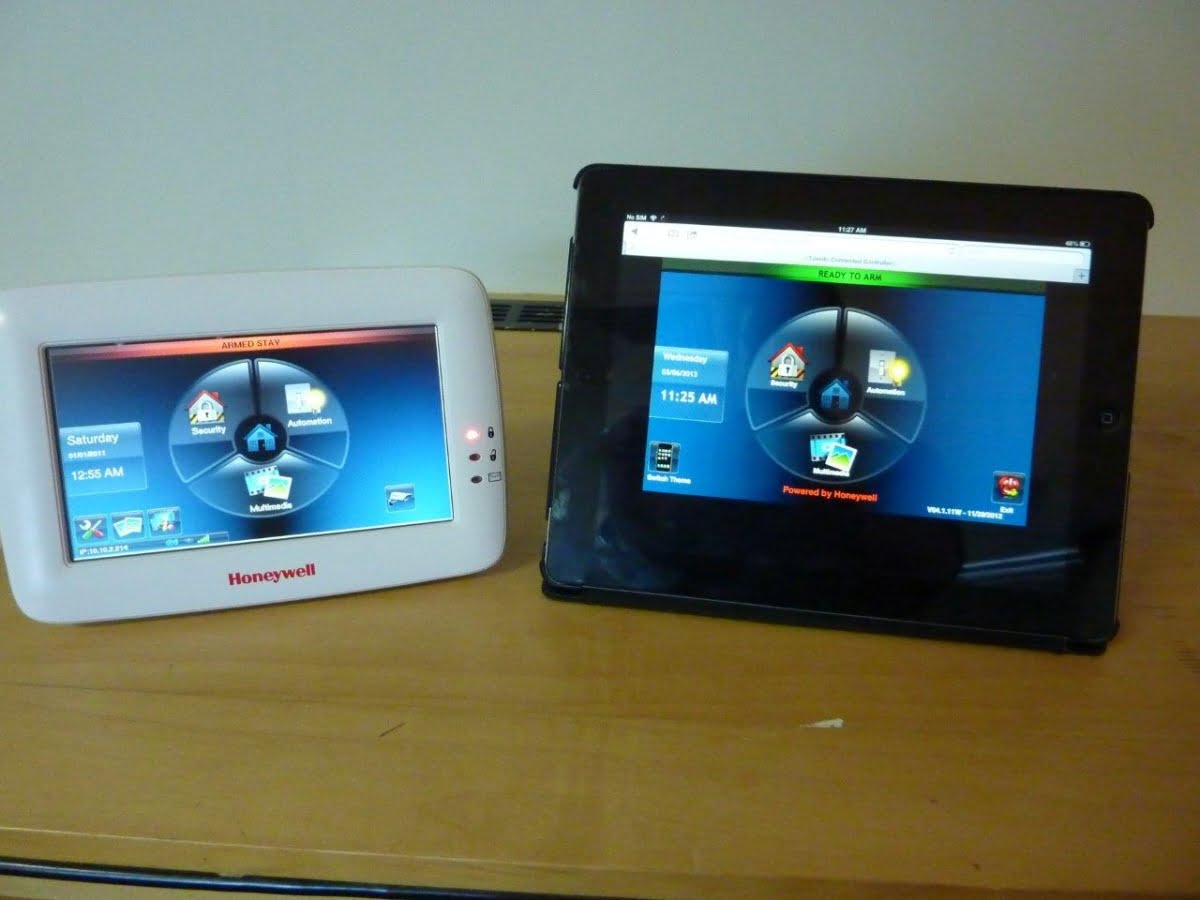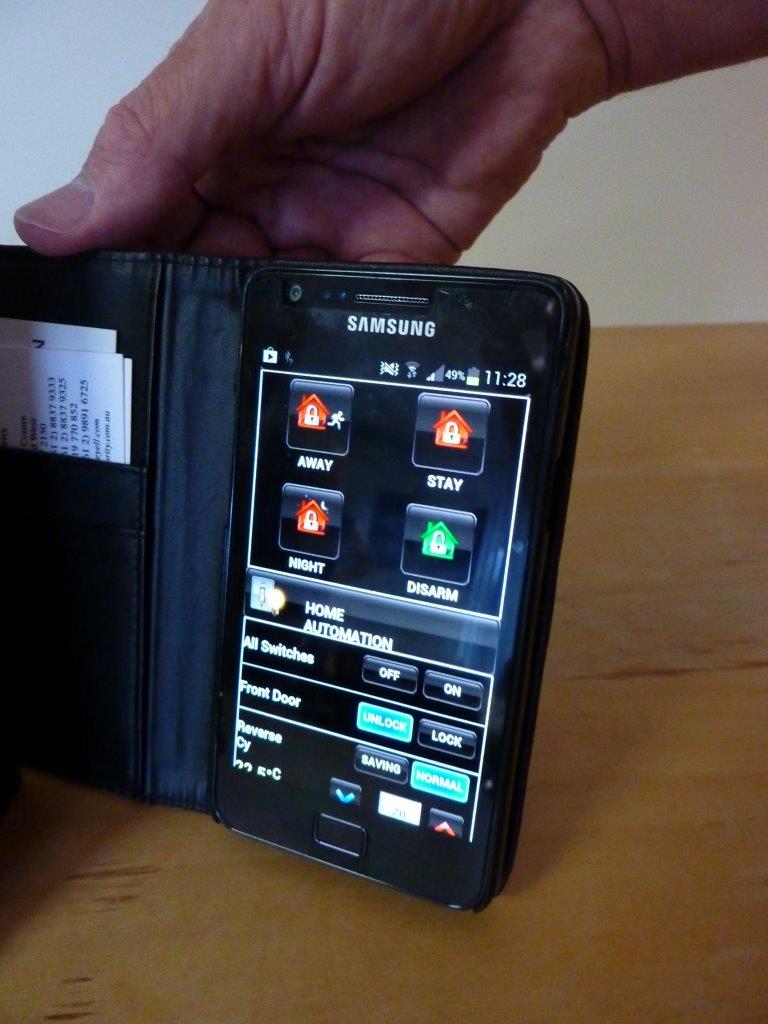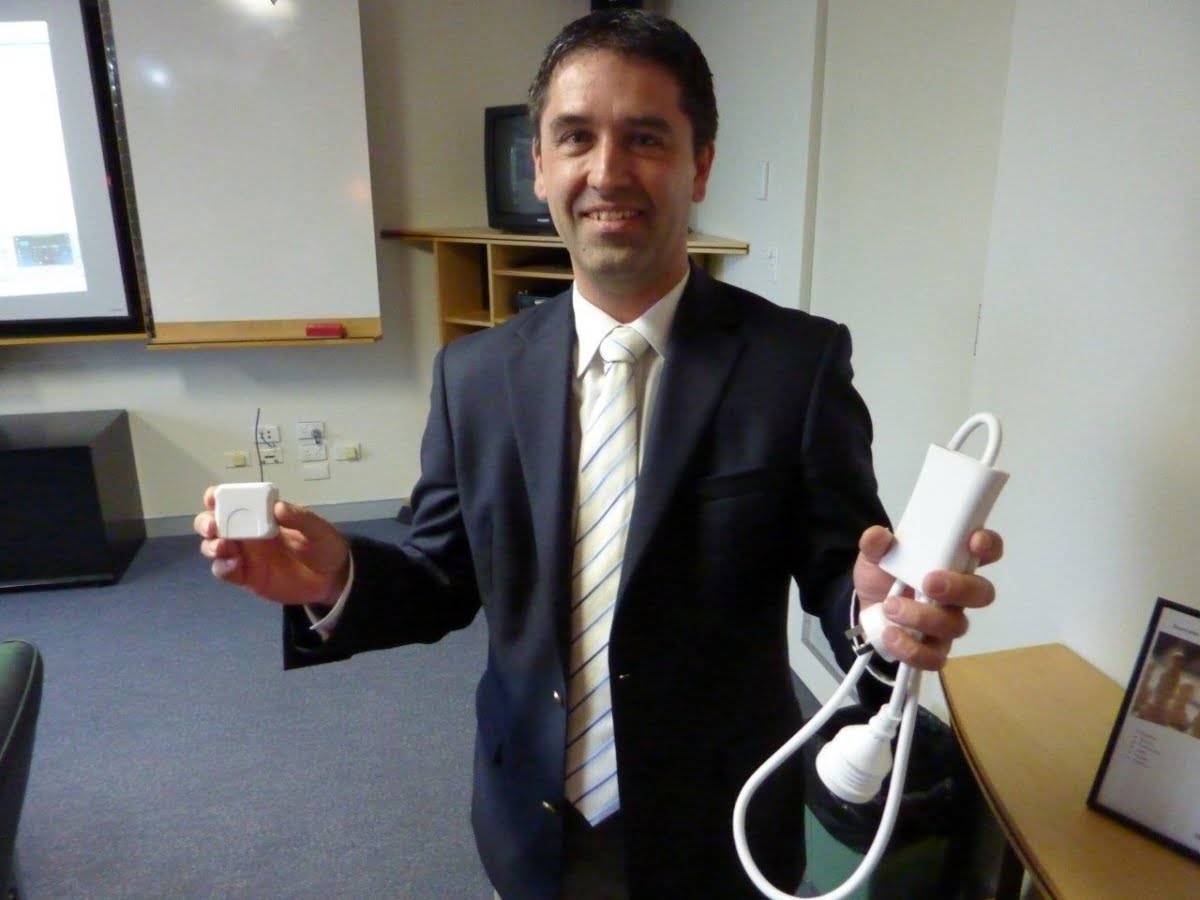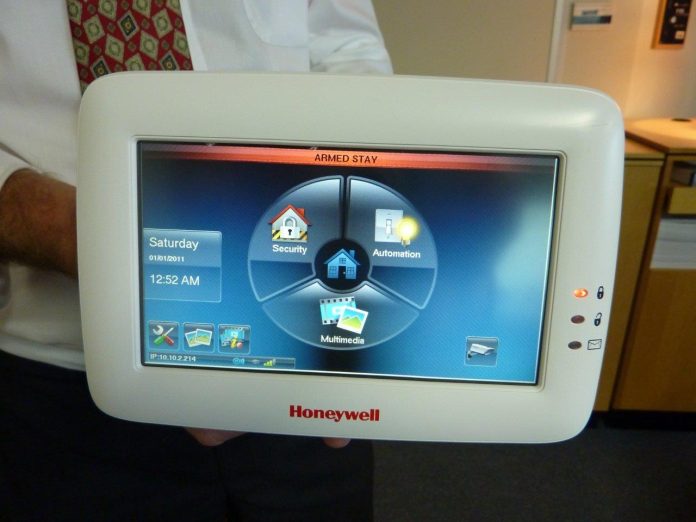HONEYWELL’S Tuxedo Touch is a child of the digital age, a web-connected touch screen portal that liberates the functionality of Honeywell’s Vista alarm panels and adds automation and multimedia functionality manageable locally or anywhere in the world.
Best of all, Tuxedo Touch empowers clever installation companies, giving them an integrated security and automation product on the one hand and a huge up-sell for every Honeywell Vista system they’ve installed for a decade on the other. Put simply, Tuxedo transforms alarm systems into automation solutions.
Physically, Tuxedo is an 18cm diameter touch screen with 800 x 480 pixel TFT display offering 16 million colours. Driven by an onboard OS, Tuxedo can operate as an alarm panel keypad, a home automation controller, a surveillance monitor, a video player and a photo frame, as well as an audio message board.
And while these facts might sound a bit bland on paper don’t be fooled. Tuxedo’s real power is as a manager and an enabler. This unit is capable of managing all the functions of the entire Vista range, retrofitting all the way back to 2002. That includes the big 128-zone panels as well as a monster 250-zoner with access control that’s due out in March 2013.
Tuxedo’s automation capabilities are no less compelling. Along with security via Vista, Tuxedo brings together up to 4 IP-based video surveillance cameras and up to 232 Z-Wave-enabled thermostats, lights, air conditioners, electric locks and automated window shades. And importantly, cost is competitive.
The woven-in consumer tech I alluded to earlier relates to Tuxedo’s networking ability and I think it’s the defining aspect of Honeywell’s youngest prodigy. Rather than being a dumb terminal, Tuxedo incorporates a built-in web server and an RJ45 port which allows authorised users to manage the system via WiFi or Ethernet from anywhere in their home or office, or from anywhere in the world, using the Tuxedo interface.
Honeywell Tuxedo and iPad app
Authorised users can link with the system via mobile devices like iPads, iPhones, Android phones or tablets, or any network-connected workstation, laptop, netbook or internet TV. What about network security, you ask? Well, there are multiple layers of security.
When you access the system remotely you use a user name and a password just as you would when accessing a secure banking server. There are choices of WEP or WPA for password hardening (I’d recommend WPA2 with AES encryption, not TKIP). At this level you can manage automation and if you want to go into the security system, then the alarm code must be entered as well.
Driving the system
Showing me round Tuxedo are Honeywell Security Group’s product manager Keith Potter and general manager, John Gellel. Both are excited about the system’s capabilities and while Potter has Tuxedo installed at home and is living with the system day to day, Gellel has a more strategic view.
According to Gellel, Honeywell initially released Tuxedo at Security 2012 and he says the solution’s development was in response to the voice of the customer and a need to give the market more of what it wants.
“The response at the time of release was very positive and installers were impressed with the system’s ability to handle retrofits and automation,” Gellel says.
“For installers looking for something different, Tuxedo is great. They can install an alarm system or, for a minimal additional cost, they can install a scalable home automation solution that can do energy management, surveillance, lighting and air conditioning control. It gets people away from the model of selling 2 or 3-sensor alarm systems.”
Gellel points out that one of the nicest things about Tuxedo is that it’s integrated with Vista as a single system, so sales routines don’t involve the confusion of 2 completely different systems. Instead Tuxedo simply expands Vista.
“Installers can show Tuxedo as part of Vista – they are not showing 2 completely different products, one handling security, the other handling automation,” Gellel explains. “That means there are not 2 completely separate systems that installers have to sell separately with 2 different sales stories.
“If a customer does not want Tuxedo they can have Vista installed and if they want Tuxedo later it can be added as an upgrade. And if the client decides to go with Tuxedo they might initially only want networked control of security and air conditioning along with 1 or 2 light circuits to start with. Then later on they might decide to put in additional automation.”
Now the boys start driving the system. In this application, which is set up at the Honeywell office in Parramatta, there’s a battery-powered Tuxedo we are using as a remote device which is communicating via Wi-Fi with a Tuxedo unit installed in the showroom of the office which is driving lights and air conditioning in the board room.
While Gellel and Potter are talking I can’t help but start playing with the touch screen on the table in front of me. Physically, Tuxedo Touch comprises a large-ish touch screen with an 18cm diameter, the screen is surrounded by a white or silver frame that’s another 3cm wide on average. The feel of the unit is relatively heavy in the hand but that’s in large part because the unit I’m holding has a battery pack attached. Everything about Tuxedo has a look and feel of quality.
Tuxedo’s home screen is simple. It’s a deep blue at the top, lightening towards the bottom of the screen. In the centre there are 3 large touch keys arranged as 3 segments of a circle, each of these 3 segments being a touch key. On the left it’s security, on the right, automation, while the bottom key is multimedia.
Underneath are 3 small keys on the left of the screen, tools, images and tutorials. At the bottom right there are 2 keys, surveillance and alerts. As you drill into the system functionality, the modular iconic layout of the management process remains the same. It’s super simple. Neat, too, at the bottom left of the home screen is Tuxedo’s IP address, in case you forget it.
Importantly the Tuxedo interface for networked computers, tablets or smart phones, mirrors the Tuxedo touch screen interface and there’s an iPad set up in the board room to show me the Tuxedo interface. It’s identical to the touch screen in appearance and function. Management and control are carried out via Wi-Fi or Ethernet allowing users to connect to the Tuxedo via the built-in web server that allows local control of the system using any Wi-Fi enabled smart device.
At this point I’m playing with the touch screen functions, going through the process of arming, disarming, staying, calling up video and checking out automation. It’s very simple to find your way through these functions. The touch pad likes a press-and-hold technique – a definite press of the button is required for perhaps a quarter of a second to activate a touch button.
The unit’s underlying management system is Linux-based and allows complete control of Vista security systems back to 2002, as well as Honeywell WiFi cameras and up to 232 compatible Z-Wave-enabled devices. There’s an extensive list of these devices and according to Gellel, most Z-Wave devices are compatible.
Something I think is especially neat is the ability of Tuxedo to manage energy costs with customized time-based, interlocking ‘scenes’ that can control Z-Wave enabled thermostats and lights based on system events or time and day. The system can hold up to 10 such scenes at a time. Operations are simple but there are inbuilt video tutorials that run users through the processes if installers or end users need help.
You have a Tuxedo system at home Keith – do you find it capable and easy to manage and expand? I ask.
“Yes, absolutely. I’m having plenty of fun with it,” says Potter, turning on a light in the board room and then dimming it.
“We have a lot of things linked to the system at home including air conditioning and cameras. These allow us to check the front door when the doorbell rings using authorised mobile devices from anywhere in the house.
“It doesn’t matter what device we integrate into the system, it can be managed using an iPhone or iPad, or a Blackberry or an Android – the user interface is identical to the Tuxedo keypad. Using the management system we can also unlock doors remotely after confirming identify using cameras.”
According to Potter, the management system inside Tuxedo currently supports 128 zones and this will expand to 250 zones with the release of a big new alarm and access control panel at the end of March.
“Tuxedo works with all our Vista panels, including the big ones,” Potter says. “The system handles arming and disarming of multiple areas, various user codes and authority levels, event logs, the whole lot.”
Android app
Installing Tuxedo
So, from the point of view of installers, how hard is it to install and program Tuxedo? Not hard at all, according to Potter.
“If you are doing a new installation you run your normal 4-core for the keypad (between panel and keypad) plus your Cat 5 cable for the LAN,” he explains. “The keypad recognises all the programmed security zones from an existing Vista system or you can program new systems directly using Tuxedo.
“When it comes to retrofit installation, techs can use the existing cabling in the home to install Tuxedo, which is powered by the panel and supported by the panel’s backup battery.”
There can be apprehension over IP connectivity but in the case of Tuxedo, things are very straightforward. Set up of Tuxedo is via Dynamic Host Configuration Protocol (DHCP) and the system operates in a client-server environment, no different to router on a home network.
“While doing the DHCP setup, installers create a local fixed IP address which is displayed on the front of the touch screen,” Potter explains. “You put that IP address into your smart phone or tablet via Safari or Internet Explorer and it takes you to the Tuxedo interface.
“Next, you then save that link as a short cut on your desktop or in favourites and you can monitor and manage the system, including arming and disarming the security system remotely. Once the system is setup, all security functions are available remotely.
“Alternatively, if you decide not to use a fixed IP address you can use a DNS web server. That means to get remote access you just match your IP address to the IP address of the web page you apply for so you can have remote access at any time.”
Handling automation is facilitated by that huge suite of compatible Z-Wave devices which let installers get seriously creative about their solutions. When Z-Wave devices are connected to the system they appear in the menu as switches that can be identified by icons including switches and bulbs.
“The Z-Wave range includes in-wall switches with the capacity to handle 10 Amp loads, and there are on/off and dimming modules,” says Potter. “There’s also an on/off switch that can be in-wall or plug – this makes it easy to get a few lamps running.
“Meantime, we are in the process of developing lock solutions – currently we have the battery-operated Schlage lock. Then there’s a range of current cameras – indoor and outdoor and a pan/tilt unit. And we are working on integrated recording. All in all it’s a totally scalable solution from an automation point of view, while from a basic security standpoint, it’s very simple to install and very easy to manage.”
According to Potter, the system can be expanded to handle remote control operations like raising and lowering curtains or blinds through outputs.
“To action the automation involves the integration of 1 extra Z-Wave module,” he says. “It’s very simple. And automation can be programmed as part of a suite so curtains can be lowered at the same time lights go on or air conditioning turns off.”
Once Z-Wave devices are connected, installers can tweak their parameters to suit.
“Remote control of lighting or automated control is ideal for holidays and saves the hassle of using timers,” Potter explains. “You can set up a scene that decrees when the system is armed then turned particular lights switch on at 7pm and then turn off at 10.30pm.
“This means when the system is disarmed and the family is home the automated lights will not come on or turn off. But, if you’re out at a party or on holiday or late home from work and the system is still armed, then the lights will be activated.”
And this applies to air conditioning, too.
Honeywell's John Gellel
“In winter it can turn on air conditioning half an hour before you wake up and then turn it off after an hour or so,” Potter says. “That programmed scene is good for 3 months a year in winter and you can have another scene for summer, which activates the air conditioning half an hour before you arrive home at night and turns it off later in the evening when the temperature has dropped. Then, when the seasons change you can just enable the summer scene and disable the winter scene, you don’t have to reprogram Tuxedo – it’s very simple.”
Gellel agrees.
“Tuxedo really is flexible, adaptable and very easy to install and manage,” he says. “There’s a whole range of universal remotes available and it’s just a matter of selecting the universal remote to suit the brand. For instance, with air conditioning, you program that remote to your local reverse-cycle air conditioning controller and let it into Tuxedo via Z-Wave wireless.
“And from Tuxedo to the lamp Keith turned on earlier the link is Z-Wave wireless. These are simple devices that any installer can plug in and manage via Tuxedo. Those Z-wave devices could be modules plugged into a power point, or hardwired modules installed in wall cavities, with each managing a light, a coffee machine, a TV.”
According to Gellel, on the alarm sensors side there are also neat things like wireless reeds and wireless asset protection sensors that you stick on the back of a boat, painting or motorcycle. These sensors incorporate an accelerometer and optical sensor technology.
“The wireless asset protector is a great little device for domestic or commercial use,” Potter explains. “It’s very compact – it becomes a zone and attaches with double-sided tape. You can set the alarm on the basis of sensitivity, length of movement time and degree of tilt.”
Tuxedo also allows installers to set up additional 3-action trigger events that can be set up based on parameters like time, an arming event, or if a thermostat reaches a threshold. These mean lights can activate at a certain time, air conditioning can activate at a certain temperature or time, and curtains can raise and lower at a certain time.
All this programming during setup is modular and easy to do.
It’s certainly good to see alarm panels evolving – there’s been a period of stagnation but the latest systems are beginning to integrate some of the best and most flexible features we see in the fast-moving consumer market.
To my mind Tuxedo represents the perfect expression of the latest generation of security high tech. It’s a solution that offers remote access, remote management, automation that’s scalable and affordable, and it integrates surveillance.
Fundamentally, Tuxedo brings any functionality you like into a security and automation system and then allows you to access that functionality from anywhere on Earth. It’s hard not to love that.














